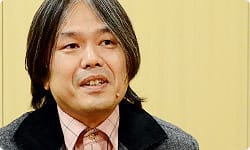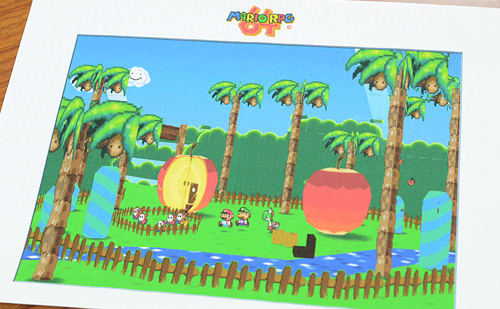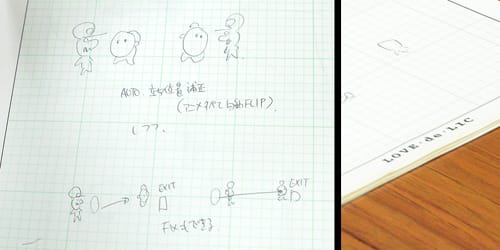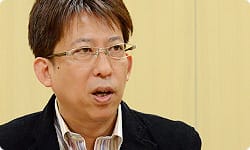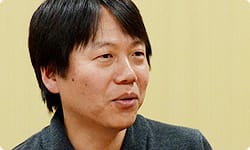"Going All Out with Stickers"
Paper Mario for the Nintendo 64 was the first game in this series of paper-thin 2D graphics. I think Miyamoto-san really persevered until achieving that unique style. As the developers at that time, what was it like?
It was indeed a challenge. After it was decided that IS would make a second Super Mario RPG, we ran into trouble deciding how it should look in order to bring out a different theme than in the main series.
Tanabe-san, you weren't very involved with Paper Mario at that time, were you?
Aside from introducing Kudo-san at the start, I didn't have much to do with it.
Oh, is that so?
Tanabe-san was in charge of handling HAL Laboratory, and he was twisting his head with me while I was at HAL Laboratory at the time about bringing out games for the Nintendo 64. (laughs)
Oh…were we? (laughs)
Around 1997, HAL Laboratory was somewhat lost. The reason was clear. The Super Mario 6418 game suddenly came out at the same time as the Nintendo 64, and we were all twisting our heads and couldn't find an answer about what product would be good enough to line up side by side with Super Mario. It took quite awhile before HAL Laboratory came out with the Super Smash Bros.19 game, and I bet IS had the same problem.
18. Super Mario 64: The first 3D action game in the Super Mario series, simultaneously released with the Nintendo 64 system in June 1996.
19. Super Smash Bros.: An action-fighting game released for the Nintendo 64 system in January 1999. It was developed by HAL Laboratory, Inc. where Satoru Iwata was once president.
Yeah, we really did. And most of all it was a Mario game! We couldn't determine the route to take with visuals. At first, we broke into teams and worked in parallel on making about three sample models.
Aoyama-san, what were you working on then?
I was still a new employee, and I was involved as a designer making one of the samples.
You were a new guy.
And while the design remained undecided, I naturally spent a lot of time waiting. Then, during that free time, casually for my own interest and totally apart from the course the team was taking, I made a rough image. I hoped it would somehow serve as a kickoff point and submitted it.
Uh-huh…
Then they called me to a planning meeting saying, "Bring back that picture," and this is what I presented.
Oh, it's from 15 years ago on March 5, 1997.
It's made of 3D polygons, but I drew it to have an atmosphere like that of a picture book transplanted into a video game—with paper-thin 2D background and characters.
This style simply didn't exist according to the path everyone was on at the time, but you could sense a great deal of feeling toward Super Mario in the pictures.
I think about that time there was a trend of going for realistic 3D in home consoles, but I thought it might be an interesting twist to make use of those capabilities to use 3D in emphasizing a 2D appearance.
(looking at a memo (→image)) Hey, this is clearly my drawing! (laughs)
It says Love-de-Lic.20 20. Love-de-Lic, Inc.: The game developer Taro Kudo was affiliated with after leaving Square Co., Ltd. When staff members struck out on their own, it divided into several companies, including Vanpool, Inc.
Kudo-san was there then, too.
In March 15 years ago, you ended up using something a new designer had made for fun.
Yeah.
I think that made a strong impression on Miyamoto-san. After the Nintendo 64 version, Aoyama-san was away from the series for a while, but then he got appointed as project director for this game.
Ah, I see. And Miyamoto-san said he wanted the visuals to follow Aoyama-san's sensibilities.
I believe so. In that respect, this project started with a near complete renewal of the staff.
A few programmers continued on in order to make use of previous assets, but in planning and design, about 90% were participating for the first time.
In some ways, I think that meant a return to Paper Mario's origins, but was there a reason for that renewal?
The biggest reason was that Miyamoto-san said he wanted us to make a big change in the atmosphere for Paper Mario this time. I heard that Miyamoto-san was really thinking for a while about how to handle the Super Mario series and pondered over a number of things.
We imagined rather early on that Paper Mario would be a good match for the Nintendo 3DS, and the papercraft atmosphere of the actual prototype was good.
That was about three years ago, at the end of 2009.
At the beginning of development, we were simply incorporating an idea making use of the stereoscopic display function. Then at the 2010 E321, before release of the Nintendo 3DS, we revealed several images. 21. E3 (Electronic Entertainment Expo): A video game trade show usually held once a year in Los Angeles.
So why did it drag on until now?
After E3, Miyamoto-san played the prototype and said it was just a port of the GC version.22 22. GC version: Paper Mario: The Thousand-Year Door, released for the Nintendo GameCube (GC) console in July 2004. It is the second game in the Paper Mario series.
I had heard that at first Miyamoto-san said that something like an RPG would be fine, so for a while I thought that something like the previous one would be fine.
That must have meant that you hadn't done much that was new.
Right. So we wondered what to do. Then the idea of using stickers came up. Originally, the plan was to use stickers here and there for solving puzzles on the overall map and so forth, but then we thought, "If we're gonna do that, then we might as well use stickers for the whole thing, including battles," and we decided to begin rethinking the game mechanics.
That's when the policy of going all out with stickers came to the forefront.
Yeah. But at first I couldn't really dig into development and couldn't easily resolve that.
You were making the Donkey Kong Country Returns23 game for the Wii console and I asked you to not get too deeply involved in other projects. 23. Donkey Kong Country Returns: An action game released for the Wii console in December 2010.
Later, Donkey Kong Country Returns was done and the new year began, and I was allowed to really dig into development at the beginning of 2011. The first thing I did was to ask Kudo-san to participate in the project.
Yes, that was about the time.
It was somewhat fateful. About the beginning of February, Kudo-san came to Kyoto to discuss a different project and said in front of me during a casual conversation about how he was so busy being a president that he never got to get involved with development.
Oh, same here! (laughs)
(laughs)
Just about that time, I wanted someone who could write good text, and I couldn't always be on site, so I was looking for someone who could be present to make calls on detailed matters. Kudo-san was perfect for that, and we had a past connection through IS, so I asked him if he could take a spot in development. I thought it was going too far to ask another company's president to come in as a staff member on a project I was in charge of, but Kudo-san consented. Then about spring of 2011, we had Miyamoto-san look at a prototype.
Uh-huh. How was it?
Personally, I thought it was better than before, but it turned out to be no good.
He said it was boring. I remember that clearly.
Listening to you talk, it sounds like Miyamoto-san was a scary presence for the team.
Yeah, he was! (laughs)
We have no shortage of the anecdotes in that nature. What we can reveal today are only a fraction of them!
(laughs)

